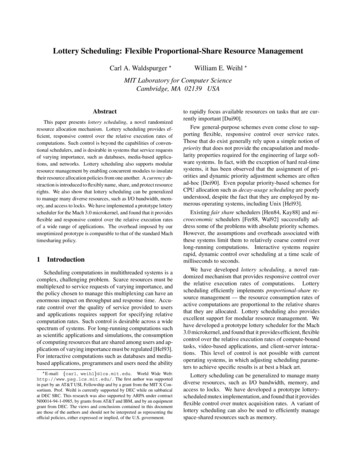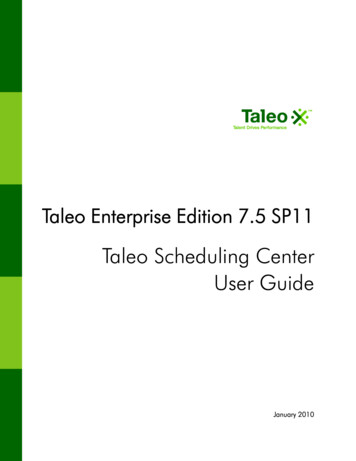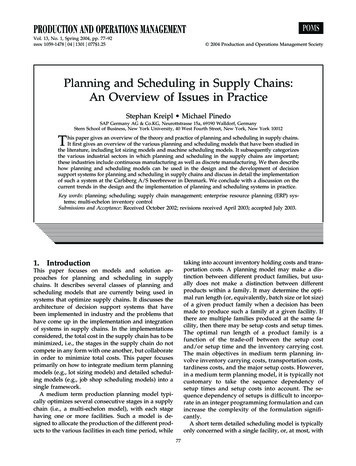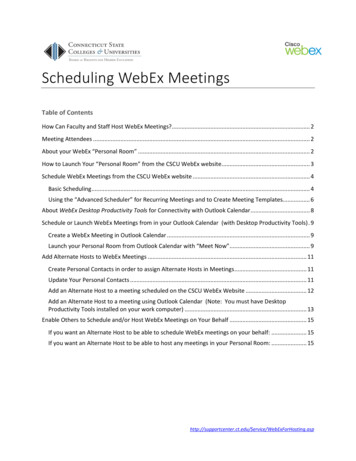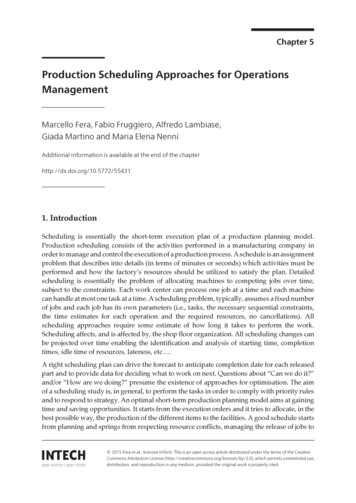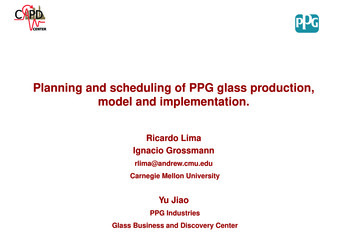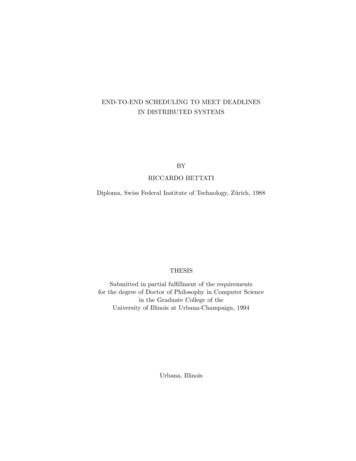
Transcription
END-TO-END SCHEDULING TO MEET DEADLINESIN DISTRIBUTED SYSTEMSBYRICCARDO BETTATIDiploma, Swiss Federal Institute of Technology, Zürich, 1988THESISSubmitted in partial fulfillment of the requirementsfor the degree of Doctor of Philosophy in Computer Sciencein the Graduate College of theUniversity of Illinois at Urbana-Champaign, 1994Urbana, Illinois
c Copyright byRiccardo Bettati1994
19942
END-TO-END SCHEDULING TO MEET DEADLINESIN DISTRIBUTED SYSTEMSRiccardo Bettati, Ph.D.Department of Computer ScienceUniversity of Illinois at Urbana-Champaign, 1994Professor Jane W.S. Liu, AdvisorIn a distributed real-time system or communication network, tasks may need to be executedon more than one processor. For time-critical tasks, the timing constraints are typically givenas end-to-end release times and deadlines. This thesis describes algorithms to schedule a classof systems where all the tasks execute on different processors in turn in the same order. Thisend-to-end scheduling problem is known as the flow-shop problem. We present several caseswhere the problem is tractable and evaluate two heuristic algorithms for the NP-hard generalcase. We generalize the traditional flow-shop model in two directions. First, we present twoalgorithms for scheduling flow shops where tasks can be serviced more than once by someprocessors. Second, we describe a technique to schedule flow shops that consist of periodictasks and to analyze their schedulability. We generalize this technique and describe how itcan be used to schedule distributed systems that can not be modeled by flow shops. We thendescribe how to combine local or global resource access protocols and end-to-end scheduling.Finally, we show that by using end-to-end scheduling we can simplify resource access protocolsand thus increase the utilization of resources.iii
To my parents, Aldo and Maria-Rosa Bettatiiv
AcknowledgementsMy deepest gratitude goes to Prof. Jane Liu, who five years ago took upon her to teach anintimidated student from overseas the tools of the trade of a researcher. She did this as a greatteacher, a fabulous advisor, and an invaluable role model. Her continuous encouragement wascrucial in helping over the periods of doubt and the occasionally arid portions of the work, andher enthusiasm and energy are always contagious.I would like to thank the other members of my committee, Professors Andrew Chien, KweiJay Lin, Dave Liu, Tony Ng, and Ben Wah, for having agreed to scrutinize and comment onthe contents of my thesis.A big “Thank you” goes to all the members of the Real-Time Systems Laboratory. Thisis a very special group, because joining it not only means acquiring new colleagues, but tyingvery dear friendships. First I would like to thank Don Gillies, with whom I had the honor toshare the office. His encyclopedic memory has saved me many hours of literature search. Donperhaps remembers that I sill owe him the Magic Jacket. The third cohabitant of our office formany years was Carol Song, the person to ask for many little tools and tricks needed for experimentation, measurement, and writing. My gratitude goes also to the remaining members of thegroup: Infan Cheong, Zhong Deng, Wu Feng, Rhan Ha, Changwen Liu, Victor Lopez-Millan,Pilar Manzano, Joseph Ng, Luis Redondo, Arjun Shankar, Wei-Kuan Shih, Ami Silberman,Matthew Storch, Too-Seng Tia, Susan Vrbsky, and Xin Wang.Over the years I learned to appreciate Champaign-Urbana as a very special place to makefriends: I met Maher Hakim the very first day I arrived and cherish our friendship very much.Marc Najork and Sam Abassi have been very good friends over the years. Sam has always hada tender hart for starving graduate students. Let me acknowledge Hoichi Cheong, Nany Hasan,Ran Libeskind-Hadas, Ernst Mücke, Roman Waupotitsch, and many others, with whom I sharemany fond memories.v
I would especially like to thank Bill and Joyce Krahling and their daughter Heidi for havingwelcomed me as part of their family. Joyce and Bill have become my American Mom and Dad,showing me many a precious side of living in America.No spouse has ever given more support to a graduate student than my wife Andrea gave tome. She went very far out of her way (five continents, actually) to let me focus on my work, butmanaged to never make me miss her warmth and affection. One life time may not be enoughfor me to make up for all the hardship Andrea had to endure in these years.This work was supported by the U.S. Navy ONR contract No. N00014-89-J-1181.vi
Table of ContentsChapter1 Introduction . . . . . .1.1 Problem Statement .1.2 Summary of Results1.3 Organization . . . . . . .Flow-Shop Model . . . . . . .The Flow Shop . . . . . . . . . .The Flow Shop with RecurrenceThe Periodic Flow Shop . . . . .8. . 8. . 10. . 123 Related Work . . . . . . . . . . . . . . .3.1 Classical Machine-Scheduling Theory3.2 Pipeline Scheduling . . . . . . . . . .3.3 Real-Time Communication . . . . .3.4 Task Assignments . . . . . . . . . . .13131415164 End-To-End Scheduling of Flow Shops . . . . . . . . .4.1 Scheduling Identical-Length Task Sets on Flow Shops4.2 Scheduling Homogeneous Task Sets on Flow Shops . .4.3 Scheduling Arbitrary Task Sets on Flow Shops . . . .4.3.1 Suboptimality of Algorithm H . . . . . . . . .4.3.2 Performance of Algorithm H . . . . . . . . . .4.4 Scheduling Highly Non-Homogeneous Task Sets . . . .171719212226382 The2.12.22.3.11365 Scheduling Flow Shops with Recurrence . . . . . . . . . . . . . . . . . . . . . .505.1 Identical Release Times . . . . . . . . . . . . . . . . . . . . . . . . . . . . . . . . 505.2 Non-Identical Release Times . . . . . . . . . . . . . . . . . . . . . . . . . . . . . . 566 End-To-End Scheduling of Periodic Flow Shops . . . . .6.1 The Phase Modification Approach . . . . . . . . . . . . .6.2 Phase Modification and Rate-Monotonic Scheduling . . .6.3 Phase Modification and General Fixed-Priority Scheduling6.4 Phase Modification and General Distributed Systems . . .6.5 Phase Modification and Loosely Coupled Systems . . . . .6262636671737 Periodic End-to-End Scheduling with Shared Resources . . . . . . . . . . .797.1 Local Resources . . . . . . . . . . . . . . . . . . . . . . . . . . . . . . . . . . . . . 797.2 Global Resources . . . . . . . . . . . . . . . . . . . . . . . . . . . . . . . . . . . . 81vii
8 Summary and Conclusion . . . . . . . . . .8.1 Summary . . . . . . . . . . . . . . . . . .8.1.1 Traditional Flow Shop Scheduling8.1.2 Flow Shops with Recurrence . . .8.1.3 Periodic Flow Shops . . . . . . . .8.2 End-to-End Schedulability Analysis . . . .8.3 Outlook . . . . . . . . . . . . . . . . . . .87888889909192A Heuristic-Supported Search for Flow-Shop Schedules . . . . .A.1 Searching for Feasible Schedules . . . . . . . . . . . . . . . . . . .A.1.1 Consistency-Enforcing Rules . . . . . . . . . . . . . . . .A.1.2 Look-Ahead Rules . . . . . . . . . . . . . . . . . . . . . .A.1.3 Look-Back Rules . . . . . . . . . . . . . . . . . . . . . . .A.2 Minimizing Total Tardiness . . . . . . . . . . . . . . . . . . . . .A.2.1 Consistency-Enforcing Rules to Minimize Total TardinessA.2.2 Conclusion . . . . . . . . . . . . . . . . . . . . . . . . . .949595100102103104106AppendixB Simulation Results for Algorithm H . . . . . . . . . . . . . . . . . . . . . . . .108C Simulation Results for Algorithm HPCC . . . . . . . . . . . . . . . . . . . . . .139Bibliography . . . . . . . . . . . . . . . . . . . . . . . . . . . . . . . . . . . . . . . . .146Vita . . . . . . . . . . . . . . . . . . . . . . . . . . . . . . . . . . . . . . . . . . . . . . .152viii
List of Tables4.14.24.34.44.5An Example of a Homogeneous Task Set. . . . . . .Task Set with Arbitrary Processing Times. . . . . .Task Set where Step 4 of Algorithm H Fails. . . . .Settings for Simulation Parameters in Experiments. .Settings for Simulation Parameters in Experiments. .5.15.2Identical-Length Task Set with Identical Release Times. . . . . . . . . . . . . . . 54Identical-Length Task Set with Arbitrary Release Times and Identical Deadlines. 556.16.26.36.46.5Set of Periodic Jobs on a Two-Processor Flow Shop. . . . . . . . . . .Unschedulable Set of Periodic Jobs on a Two-Processor Flow Shop. . .Refined Schedulability Bounds for Rate-Monotonic Scheduling . . . . .Unschedulable Job System with Rate-Monotonic Priority Assignment.Priority Assignment that Guarantees Schedulability. . . . . . . . . . .7.17.2Schedulability Analysis Using Phase-Modification. . . . . . . . . . . . . . . . . . 83Results of Schedulability Analysis Using MPCP. . . . . . . . . . . . . . . . . . . 85ix.21252630486465666669
List of Figures2.12.2Visit Graph for Visit Sequence V (1, 2, 3, 2, 4). . . . . . . . . . . . . . . . . . . 11Visit Graph for Visit Sequence V (1, 2, 3, 4, 5, 2, 3, 6). . . . . . . . . . . . . . . . 114.14.24.34.44.54.64.74.84.94.10Algorithm A. . . . . . . . . . . . . . . . . . . . . . . . . . . . . . . . . . . . . .Schedule Generated by Algorithm A. . . . . . . . . . . . . . . . . . . . . . . . .Algorithm H for Scheduling Arbitrary Tasks in Flow Shops. . . . . . . . . . . .Algorithm C. . . . . . . . . . . . . . . . . . . . . . . . . . . . . . . . . . . . . .A Schedule Produced by Algorithm H. . . . . . . . . . . . . . . . . . . . . . . .Schedules for Two Choices of Bottleneck Processors. . . . . . . . . . . . . . . .Success Rate of Algorithm H for Small Task Sets. . . . . . . . . . . . . . . . .Success Rate of Algorithm H for Larger Task Sets (µ u 0.2, στ 0.1). . . . .Preemption not Always Pays Off. . . . . . . . . . . . . . . . . . . . . . . . . . .Algorithm PCC for Scheduling Task Sets with Two Classes of Identical-LengthTasks. . . . . . . . . . . . . . . . . . . . . . . . . . . . . . . . . . . . . . . . . .Transforming an Arbitrary Schedule into a PCC Schedule. . . . . . . . . . . . .Ta(j 1) Starts at Time t. . . . . . . . . . . . . . . . . . . . . . . . . . . . . . . .Effect of Inconsistent Deadlines. . . . . . . . . . . . . . . . . . . . . . . . . . . .Algorithm HPCC for Scheduling Task Sets with Short and Long Tasks. . . . .4.114.124.134.14.202122242527313135.3941424446. 51. 545.45.55.6Algorithm R to Schedule Flow Shops with Single Simple Loops. . . . . . . . . .Schedule Generated by Algorithm R. . . . . . . . . . . . . . . . . . . . . . . . .Applying Algorithm R to Task Set with Arbitrary Release Times and IdenticalDeadlines. . . . . . . . . . . . . . . . . . . . . . . . . . . . . . . . . . . . . . . .Algorithm RR to Schedule Flow Shops with Single Simple Loops. . . . . . . .Network G (V, E). . . . . . . . . . . . . . . . . . . . . . . . . . . . . . . . . .Algorithm F Used in Step 1(b) of Algorithm RR. . . . . . . . . . . . . . . . .555759606.16.26.36.46.56.6Higher-Priority Subjobs Interfering with J ij . . . . . . . . . . . . . . .The FPA Problem. . . . . . . . . . . . . . . . . . . . . . . . . . . . .Collection of Flow-Shops. . . . . . . . . . . . . . . . . . . . . . . . .A System That Can Not Be Modeled as a Collection of Flow-Shops.The Deferred Execution Problem in Flow Shops. . . . . . . . . . . .Comparison of Synchronous and Asynchronous Method. . . . . . . .6770727375787.17.2A System with One Local Resource. . . . . . . . . . . . . . . . . . . . . . . . . . 80A System with One Global Resource. . . . . . . . . . . . . . . . . . . . . . . . . . 828.1Different Algorithms for Different Flow Shops. . . . . . . . . . . . . . . . . . . . 895.15.25.3.A.1 Procedure S, Describing the Basic Search Algorithm. . . . . . . . . . . . . . . . . 96A.2 Procedure S T to Minimize Total Tardiness. . . . . . . . . . . . . . . . . . . . . . 103B.1 Relative Performance: 4 Tasks, 4 Processors. . . . . . . . . . . . . . . . . . . . . 109B.2 Relative Performance: 4 Tasks, 14 Processors. . . . . . . . . . . . . . . . . . . . . 110x
9B.30Relative Performance: 4 Tasks, 22 Processors. .Relative Performance: 14 Tasks, 4 Processors. .Relative Performance: 14 Tasks, 14 Processors.Relative Performance: 14 Tasks, 22 Processors.Relative Performance: 22 Tasks, 4 Processors. .Relative Performance: 22 Tasks, 14 Processors.Relative Performance: 22 Tasks, 22 Processors.Success Rate: 4 Tasks, 4 Processors. . . . . . .Success Rate: 4 Tasks, 14 Processors. . . . . . .Success Rate: 4 Tasks, 22 Processors. . . . . . .Success Rate: 14 Tasks, 4 Processors. . . . . . .Success Rate: 14 Tasks, 14 Processors. . . . . .Success Rate: 14 Tasks, 22 Processors. . . . . .Success Rate: 22 Tasks, 4 Processors. . . . . . .Success Rate: 22 Tasks, 14 Processors. . . . . .Success Rate: 22 Tasks, 22 Processors. . . . . .Relative Performance: στ 0.05, µu 0.2. . . .Relative Performance: στ 0.5, µu 0.2. . . .Relative Performance: στ 0.05, µu 0.4. . . .Relative Performance: στ 0.5, µu 0.4. . . .Relative Performance: στ 0.05, µu 0.7. . . .Relative Performance: στ 0.5, µu 0.7. . . .Success Rate: στ 0.05, µu 0.2. . . . . . . .Success Rate: στ 0.5, µu 0.2. . . . . . . . .Success Rate: στ 0.05, µu 0.4. . . . . . . .Success Rate: στ 0.5, µu 0.4. . . . . . . . .Success Rate: στ 0.05, µu 0.7. . . . . . . .Success Rate: στ 0.5, µu 0.7. . . . . . . . C.6Relative Performance: 4 Tasks, 12 Processors. .Relative Performance: 12 Tasks, 12 Processors.Relative Performance: 20 Tasks, 12 Processors.Success Rate: 4 Tasks, 12 Processors. . . . . . .Success Rate: 12 Tasks, 12 Processors. . . . . .Success Rate: 20 Tasks, 12 Processors. . . . . .140141142143144145xi
Chapter 1IntroductionIn distributed real-time systems, tasks often are decomposed into chains of subtasks. In order toexecute, each subtask requires the exclusive use of some resource, referred to here as a processor.We use the terms task and subtask to mean individual units of work that are allocated resourcesand then processed, that is, executed. For example, a subtask may be a granule of computation,a disk access, or a data transmission. Its execution may require a computer, a disk controller,or a data link, all modeled as processors. A task typically consists of many subtasks, which dosome computations, access files, and transmit messages in turn. If such a task is time-critical,its timing constraints, derived naturally from its timing requirements, are typically given by itsend-to-end release time and deadline. The end-to-end release time of a task is the time instantafter which its first subtask can begin execution. Its end-to-end deadline is the time instantby which its last subtask must be completed. As long as these end-to-end constraints are met,when the individual subtasks are executed is not important.1.1Problem StatementThis thesis is concerned with scheduling tasks that execute in turn on different processors andhave end-to-end release-time and deadline constraints. It focuses on the case where the systemof tasks to be scheduled can be characterized as a flow shop or a variation of a flow shop. A flowshop models a distributed system or communication network in which tasks execute on differentprocessors, devices, and communication links (all modeled as processors) in turn, following thesame order.An example of the type of systems studies here is a distributed multimedia system. Thissystem consists of a video server that accesses and delivers video data, one or more hosts thatreceive and display the data, and a communication network that connects the display hosts tothe video server. The video data consists of streams of frames. We model the access, delivery,and display of each stream of data frames as a task, which consists of three subtasks. The first1
subtask is the access and delivery of the data frame on the video server; the second subtaskis the transmission of the data on the network from the video server to the requesting host;the third subtask is the acquisition and display on the host. These subtasks must be scheduledon the corresponding processors. The timing constraints of the task as whole are given by themaximum end-to-end delay between the request for and the display of a single frame of data.We study here how to schedule such a task to meet its deadline in the presence of similar tasks.We note that each subtask in above example may need to be further decomposed intosubtasks and, hence it is itself a task with end-to-end timing constraints. The task runningon the video server for instance may consist of a subtask running on the disk controller anda second subtask that acquires buffer space and delivers the data to the underlying network.The communication network that delivers the data frames to the display hosts may be a multihop (generally a packet-switched) network. The tasks, modeling the transmission of real-timemessages along a virtual circuit in such a network, consist of chains of subtasks, each subtaskforwarding the message through one hop. The timing constraints for the transmission of themessages are end-to-end.In a similar example, we consider a distributed system containing an input computer, aninput link, a computation server, an output link, and an output computer. The input computerreads all sensors and preprocesses the sensor data. The processed sensor data is transmitted overthe input link that connects the input computer to the computation server. The computationserver computes the control law and generates commands. The commands are transmittedover its output link to the output computer, which performs D/A conversion and delivers thecommands to the actuators. In our model, each tracker and controller is a task. Its releasetime and deadline arise from its required response. Each task consists of five subtasks: the firstsubtask is the processing of the sensor data on the input computer; the second subtask is thetransmission of sensor data on the input link; and so on. These subtasks must be scheduled onthe corresponding processors to meet the overall deadline. Again, how the individual subtasksare scheduled is not important as long as this overall deadline is met.End-to-end timing constraints are not necessarily limited to distributed systems. In manyinstances we can think of a task accessing a non-sharable resource as temporarily executing onthat resource. After the task releases the resource, it returns to execute
END-TO-END SCHEDULING TO MEET DEADLINES IN DISTRIBUTED SYSTEMS Riccardo Bettati, Ph.D. Department of Computer Science University of Illinois at Urbana-Champaign, 1994 Professor Jane W.S. Liu, Advisor In a distributed real-

